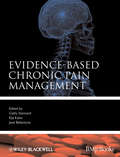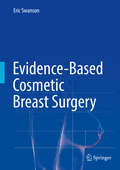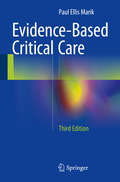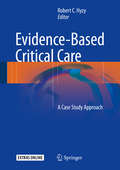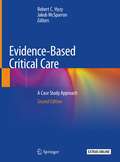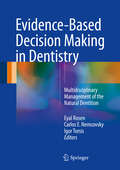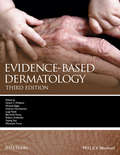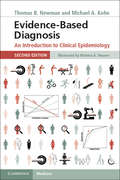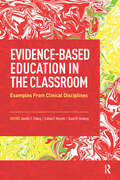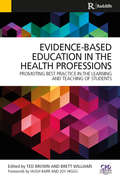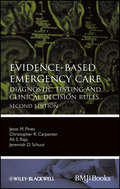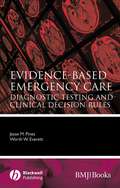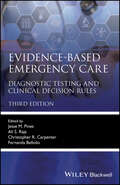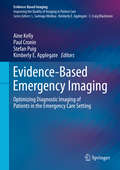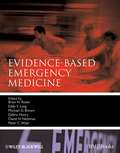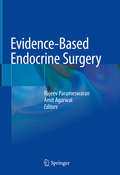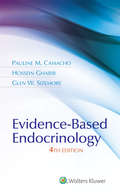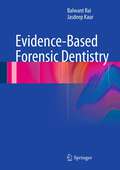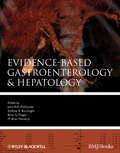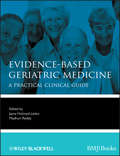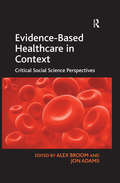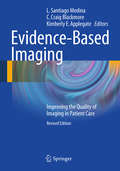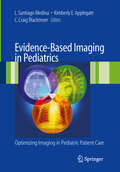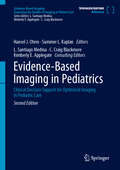- Table View
- List View
Evidence-Based Chronic Pain Management
by Cathy Stannard Jane Ballantyne Eija KalsoA genuine evidence-based text for optimum pain relief in various chronic conditionsContributes an important advance in the practice of pain management providing the information on which to build more coherent and standardised strategies for relief of patient sufferingAnswers questions about which are the most effective methods, AND those which are not effective yet continue to be usedIncludes discussion of the positive and the negative evidence, and addresses the grey areas where evidence is ambivalentWritten by the world's leading experts in evidence-based pain management this is a seminal text in the field of pain
Evidence-Based Cosmetic Breast Surgery
by Eric SwansonInsisting on an evidence-based approach, Dr. Swanson brings the light of science to bear on the many controversies in cosmetic breast surgery today. Conventional wisdom is challenged with factual analysis, made possible by Dr. Swanson's large body of published research. In his hallmark detailed style, the author lays the foundation with clinical studies, measurements, and patient-reported outcomes. The work is all here in one place for the first time, leading to some surprising conclusions. For plastic surgeons who prefer data to dogma, Evidence-Based Cosmetic Breast Surgery provides a unique and invaluable resource.
Evidence-Based Critical Care
by Paul Ellis MarikThis is the premier evidence-based textbook in critical care medicine. The Third Edition features updated and revised chapters, numerous new references, streamlined content, and new chapters on key topics such as the new paradigm in critical care medicine, cardiac output monitoring, surgical optimization, vital signs, and arterial blood gas analysis. The book maintains the author's trademark humor and engaging writing style and is suitable for a broad and diverse audience of medical students, residents, fellows, physicians, nurses, and respiratory therapists who seek the latest and best evidence in critical care. From reviews of previous editions: "This is an excellent introduction to the concept of evidence-based medicine. . . The writing is clear, logical, and highly organized, which makes for fast and enjoyable reading. I believe this book will get daily use in most intensive care units, by a wide range of readers. " -Respiratory Care "This is one of the most comprehensive handbooks on critical care medicine with a strong emphasis on evidence base. . . Overall, this book should be useful for junior doctors or intensive care trainees who are starting their term in an intensive care unit. " -Anaesthesia and Intensive Care
Evidence-Based Critical Care
by Robert C. HyzyThis book provides learners with a unique opportunity by virtue of the format outlined above. Each case presentation has a case vignette, which leads up to an important clinical question, and is followed by additional discussion which resolves the question posed. This is a new way to present knowledge in a medical book and should help critical care practitioners, fellows, residents, allied health professionals and students expand their critical care knowledge in an efficient and effective manner. This approach should also benefit those preparing for board examinations.
Evidence-Based Critical Care: A Case Study Approach
by Robert C. Hyzy Jakob McSparronThis extensively updated textbook comprehensively reviews the latest developments in evidence-based critical care. Topics are covered in a case study format with an emphasis on the principles of diagnosis and therapy. Each topic is covered using a variety of case studies and features a case vignette, clinical question and an additional discussion section to clarify areas of particular importance. Topics including cytokine release syndrome, sympathomimetic overdose and palliative care in the intensive care unit have been extensively revised, while new sections focusing on neuromuscular disease and subarachnoid hemorrhages have been added. Evidence-Based Critical Care, 2nd edition is a critical resource for critical care practitioners, fellows, residents; allied health professionals and medical students who wish to expand their knowledge within critical care. The case study-based approach taken in the textbook makes this an ideal resource for those preparing for board examinations.
Evidence-Based Decision Making in Dentistry
by Igor Tsesis Eyal Rosen Carlos E. NemcovskyThis clinically oriented book covers all aspects of the evidence-based decision making process in multidisciplinary management of the natural dentition. The book opens by clarifying the principles of evidence-based decision making and explaining how these principles should be applied in daily practice. Individual chapters then focus specifically, and in detail, on endodontic, periodontal, and prosthetic considerations, identifying aspects that need to be integrated into decision making and treatment planning. Evidence-based decision making with regard to preservation of the natural tooth versus extraction and implant placement is then discussed, and a concluding chapter examines likely future trends in dentistry and how they may affect clinical decision making. The authors include leading endodontists, periodontists, and prosthodontists. Given the multidisciplinary and comprehensive nature of the book, it will be relevant and interesting to the entire dental community.
Evidence-Based Dermatology
by Berthold Rzany Hywel Williams Michael Bigby Masutaka Furue Luigi Naldi Robert Dellavalle Andrew Herxheimer Yuping RanBe sure your skin-care treatments have strong evidential support Evidence-based Dermatology, Third Edition takes a unique approach to clinical dermatology by emphasising use of only the highest quality available evidence when treating people with skin diseases.Beginning with a toolbox introduction to the practice of evidence-based dermatology, it then covers the application of evidence for dermatological treatments across a wide range of ailments, including:* Common inflammatory skin diseases* Skin cancer, moles and actinic keratoses* Infective skin disease, exanthems and infestations* Disorders of pigmentationIn addition, many of the rarer skin disorders are also included so as to provide comprehensive coverage of the topic.World-leading experts in dermatology follow a clinical approach for each disease, and as well as providing their expert guidance on the description and diagnosis of dermatologic disorders, they also discuss common dilemmas that clinicians face when considering the best approach to patient management. 'Key Points' accompany each chapter to provide a quick review of the most important points.Clinically oriented and practically focused, Evidence-based Dermatology ensures that your treatments are entirely patient-focused and fully supported by the very latest medical evidence.
Evidence-Based Diagnosis
by Thomas B. Newman Michael A. KohnEvidence-Based Diagnosis is a textbook about diagnostic, screening, and prognostic tests in clinical medicine. The authors' approach is based on many years of experience teaching physicians in a clinical research training program. Although requiring only a minimum of mathematics knowledge, the quantitative discussions in this book are deeper and more rigorous than in most introductory texts. The book includes numerous worked examples and 60 problems (with answers) based on real clinical situations and journal articles. The book will be helpful and accessible to anyone seeking to select, develop, or market medical tests. Topics covered include: the diagnostic process, test reliability and accuracy, likelihood ratios, and ROC curves, testing and treatment thresholds, critical appraisal of studies of diagnostic, screening and prognostic tests, test independence and methods of combining tests, quantifying treatment benefits using randomized trials and observational studies, Bayesian interpretation of P values and confidence intervals and challenges for evidence-based diagnosis and evidence-based medicine.
Evidence-Based Diagnosis: An Introduction to Clinical Epidemiology
by Thomas B. Newman Michael A. KohnMedicine is becoming increasingly reliant on diagnostic, prognostic and screening tests for the successful treatment of patients. With new tests being developed all the time, a more informed understanding of the benefits and drawbacks of these tests is crucial. Providing readers with the tools needed to evaluate and interpret these tests, numerous real-world examples demonstrate the practical application and relevance of the material. The mathematics involved are rigorously explained using simple and informative language. Topics covered include the diagnostic process, reliability and accuracy of tests, and quantifying treatment benefits using randomized trials, amongst others. Engaging illustrations act as visual representations of the concepts discussed in the book, complementing the textual explanation. Based on decades of experience teaching in a clinical research training program, this fully updated second edition is an essential guide for anyone looking to select, develop or market medical tests.
Evidence-Based Education in the Classroom: Examples From Clinical Disciplines
by Jennifer Friberg Colleen Visconti Sarah GinsbergEvidence-Based Education in the Classroom: Examples From Clinical Disciplines shows educators how to use evidence to inform teaching practices and improve educational outcomes for students in clinically based fields of study.Editors and speech-language pathologists Drs. Jennifer C. Friberg, Colleen F. Visconti, and Sarah M. Ginsberg collaborated with a team of more than 65 expert contributors to share examples of how they have used evidence to inform their course design and delivery. Each chapter is set up as a case study that includes: A description of the teaching/learning context focused on in the chapter A brief review of original data or extant literature being applied A description of how evidence was applied in the teaching/learning context Additional ideas for how evidence could be applied in other teaching/learning contexts across clinical disciplines Additional resources related to the pedagogy described in the case study (e.g., journal articles, books, blogs, websites) Educators in the fields of speech-language pathology, audiology, nursing, social work, sports medicine, medicine, dietetics, dental assisting, physician assisting, radiology technology, psychology, and kinesiology—already familiar with evidence-based practice—will find this resource helpful in implementing evidence-informed approaches to their teaching.While the content in clinical programs is quite different, there are many similarities in how to teach students across such programs. Evidence-Based Education in the Classroom: Examples From Clinical Disciplines highlights these similarities and represents a masterclass in how to practice evidence-based education.
Evidence-Based Education in the Health Professions: Promoting Best Practice in the Learning and Teaching of Students
by Brett Williams Ted BrownEvidence-based education is an attempt to find, critique and implement the highest quality research evidence that underpins the education provided to students.This comprehensive book presents concepts key to evidence-based education, learning and teaching, analysing a wide range of allied health professions in depth. It introduces unique, inspirati
Evidence-Based Emergency Care
by Jesse M. Pines Ali S. Raja Christopher R. Carpenter Jeremiah D. SchuurThis book for emergency physicians and fellows training in emergency medicine provides evidence-based information on what diagnostic tests to ask for and when and how to use particular decision rules. The new edition builds on the success of the current book by modifying the presentation of the evidence, increasing the coverage, and updating the current information throughout.
Evidence-Based Emergency Care: Diagnostic Testing and Clinical Decision Rules (Evidence-Based Medicine #67)
by Jesse M. Pines Worth W. EverettThis useful handbook provides a concise compilation of the evidence supporting diagnostic testing and clinical decision rules in emergency care. Clinical decision rules are now widely recognised as best practice for the ordering of diagnostic tests in the emergency department. Aimed at all physicians working with emergency and acute patients, the book begins with an overview of how to evaluate a diagnostic test using an evidence-based approach, followed by an explanation of the clinical decision rules and the methods of assessing the strength and applicability of the clinical prediction rule. These introductory chapters are followed by sections covering the following clinical areas: * Traumatic Injuries * Cardiology * Infectious Disease * Surgical and Abdominal Complaints * Urology * Neurology * Ophthalmology, Hematology, Rheumatology * Pulmonology. For each test and clinical decision rule, the most current and best available studies in the literature are discussed and applied to emergency department and acute care patients in addressing the question at hand, followed by an overall recommendation on how to use the test or rule in the clinical context. Evidence-Based Emergency Care is an accessible and extremely useful reference for physicians at all levels to use in applying an evidence-based approach to ordering and interpreting tests in an acute care environment.
Evidence-Based Emergency Care: Diagnostic Testing and Clinical Decision Rules (Evidence-Based Medicine)
by Jesse M. Pines Ali S. Raja Christopher R. Carpenter Fernanda BellolioEVIDENCE-BASED EMERGENCY CARE DIAGNOSTIC TESTING AND CLINICAL DECISION RULES THIRD EDITION Improve and streamline the diagnostic decision-making process in emergency care The newly revised third edition of Evidence-Based Emergency Care: Diagnostic Testing and Clinical Decision Rules offers an updated review of the evidence and expert discussion of relevant issues in diagnostic testing in the everyday practice of emergency medicine. This book also provides a detailed overview of the science of diagnostic testing and reviews the process behind the development of clinical decision rules. The focus is asking and answering practical questions using original research studies, while commenting on the best available evidence for relevant clinical topics. Readers will also find: Comprehensive explorations of COVID-19, telemedicine, trauma, cardiology, infectious disease, and surgical and abdominal complaints Practical discussions of urology, neurology, hematology, ophthalmology, pulmonology, rheumatology, and geriatric medicine Exploration of practice and policy considerations of testing in an era of limited resources The book is perfect for emergency medicine physicians, nurses, and other allied health professionals. Readers of Evidence-Based Emergency Care: Diagnostic Testing and Clinical Decision Rules, Third Edition will also earn a place in the libraries of administrators and managers in healthcare settings seeking to optimize the use of scarce resources while maintaining the highest standards of care.
Evidence-Based Emergency Imaging: Optimizing Diagnostic Imaging Of Patients In The Emergency Care Setting (Evidence-based Imaging Ser.)
by Kimberly E. Applegate Aine Kelly Paul Cronin Stefan PuigThis book presents evidence-based criteria to systematically assess the appropriate use of medical imaging in the emergency department and other acute care settings. Over the last decade, there have been profound changes in the diagnostic testing and work-up of patients presenting to the emergency department with emergent symptoms. One of the most far-reaching changes has been the increased availability, speed, and accuracy of imaging due, in part, to technical improvements in imaging modalities such as CT, MR, and PET. Although the use of high-end imaging has plateaued in general, increased utilization continues in the ED. These patients are more acutely ill and there is additional pressure to make an accurate diagnosis as quickly as possible to facilitate prompt disposition or treatment. There is also strong evidence for the beneficial use of imaging in the emergency setting that results in improved patient outcomes. This book answers that need by providing protocols and guidelines for neuroradiological, cardiothoracic, abdominal and pelvic, musculoskeletal, and pediatric imaging are reviewed in terms of the available imaging modalities, diagnostic criteria, and treatment options. Distinguished by its unique focus on evidence-based emergency imaging in adults, children, and special populations, this book is a unique resource for radiologists, emergency medicine physicians, and physicians in other specialties who need to be informed about the most appropriate uses of diagnostic imaging in the emergency care setting.
Evidence-Based Emergency Medicine
by David H. Newman Debra Houry Peter C. Wyer Brian Rowe Michael D. Brown Eddy S. LangEmergency physicians assess and manage a wide variety of problems from patients presenting with a diversity of severities, ranging from mild to severe and life-threatening. They are expected to maintain their competency and expertise in areas where there is rapid knowledge change.Evidence-based Emergency Medicine is the first book of its kind in emergency medicine to tackle the problems practicing physicians encounter in the emergency setting using an evidence-based approach. It summarizes the published evidence available for the diagnosis and treatment of common emergency health care problems in adults. Each chapter contextualizes a topic area using a clinical vignette and generates a series of key clinically important diagnostic and treatment questions. By completing detailed reviews of diagnostic and treatment research, using evidence from systematic reviews, RCTs, and prospective observational studies, the authors provide conclusions and practical recommendations.Focusing primarily on diagnosis in areas where evidence for treatment is well accepted (e.g. DVTs), and treatment in other diseases where diagnosis is not complex (e.g. asthma), this text is written by leading emergency physicians at the forefront of evidence-based medicine. Evidence-based Emergency Medicine is ideal for emergency physicians and trainees, emergency department staff, and family physicians specialising in the acute care of medical and injured patients.
Evidence-Based Endocrine Surgery
by Amit Agarwal Rajeev ParameswaranIn this textbook, leading experts from highly acclaimed institutions describe evidence-based best practice in the management of a wide range of benign and malignant thyroid, parathyroid, adrenal, and neuroendocrine conditions. Detailed attention is devoted to the current role of surgery, including minimally invasive surgery and robotic surgery, in different endocrine disorders. The reader will also learn how best to respond to the problems that may be encountered during endocrine surgical practice. While much of the focus is on surgical aspects, the approach is multidisciplinary, with inclusion of information on recent advances in epidemiology, genetics, cytology, pathology, imaging modalities, and other treatment options. The clear text is complemented by instructive clinical cases as well as numerous high-quality illustrations and tables summarizing key points. This book will be of value for specialists in endocrine medicine and surgery as well as general surgeons with an interest in endocrine surgery.
Evidence-Based Endocrinology
by Pauline M. CamachoProviding summaries of the latest and best publications, clinical trials, and evidence in endocrinology, this portable handbook is a time-saving addition to your professional library. In a concise, easy-to-read format, it offers evidence-based recommendations for the diagnosis and treatment of endocrine disorders and provides a comprehensive summary of pertinent clinical studies supporting the practice recommendations.
Evidence-Based Forensic Dentistry
by Jasdeep Kaur Balwant RaiRecent years have witnessed significant advances in forensic odontology. This book presents basic concepts in the field and describes all the standard examination procedures currently employed in the acquisition of dental evidence. Detailed information is provided on the identification of unknown individuals, the application of forensic dentistry in mass disasters and multiple fatality incidents, the role of dental evidence in child abuse investigations, and the analysis of bite mark evidence. Other features of the book are a series of high-profile cases, clear advice on the writing of legal reports, and discussion of the significance of DNA and oral fluid in forensic odontology. The text is supplemented by numerous high-quality figures, many of them in color. This book will be invaluable for dental examiners and pathologists, legal and police science professionals, and dentists who want to use their training and experience in an interesting and challenging way.
Evidence-Based Gastroenterology and Hepatology (Evidence-Based Medicine #60)
by John Wd McDonald Andrew K Burroughs Brian G Feagan M Brian FennertyThe only evidence-based resource combining gastroenterology and hepatology, this major textbook critically appraises the evidence for diagnosis, screening, and treatment of gastrointestinal and hepatic diseases, and provides clear recommendations for management. A unique feature is the grading of both the evidence (randomized controlled trials, systematic reviews, or lower quality trials) and the treatment recommendations. This structure provides the reader with valuable guidance on implementation. The third edition has been fully revised, providing the latest reviews of the evidence. It is also enhanced with new topics that have significant evidence for treatment, including; Esinophilic esophagitis Acute dysenteries Prevention and treatment of travellers’ diarrhoea Frequency of adverse drug effects on bowel function Management of hepatitis B Management of Hepatitis C Vascular disorder of the liver Non invasive diagnosis of liver fibrosis Drug induced liver disease
Evidence-Based Geriatric Medicine: A Practical Clinical Guide (Evidence-Based Medicine #81)
by Madhuri Reddy Jayna M. Holroyd-LeducThe latest addition to the Evidence-Based Book series, Evidence-Based Geriatric Medicine provides non-geriatrician clinicians an overview of key topics central to the care of the older patient. This guide focuses on the management of common problems in the elderly taking into account their life situations as well as treatment of specific conditions. Leading geriatricians with expertise in evidence-based medicine utilize the best available evidence and present this information in a concise, easy-to-use, question-based format. Evidence-Based Geriatric Medicine is a unique guide to the optimum management of older patients.
Evidence-Based Healthcare in Context: Critical Social Science Perspectives
by Jon AdamsWith new methods of treatment standardisation resulting in various benefits for patient outcomes, evidence-based medicine and evidence-based practice have emerged as defining features of western healthcare provision in recent years. Most health professions are now adopting some form of 'evidence-based' framework for clinical training and practice. However, the rise of evidence-based healthcare has drawn sustained criticism regarding the limits of trial based evidence, the reductive character of epidemiological study designs, and the potential for an erosion of the importance of lay perspectives and clinical judgement. Evidence-Based Healthcare in Context introduces readers to the social, cultural and historical underpinnings of 'evidence' in healthcare, critically examining questions about what constitutes ’evidence’ and ’effectiveness’ from perspectives outside medicine, including those of patients, complementary medicine and midwifery. It focuses on the application of contemporary theoretical debates around the nature of medical and health knowledge, providing readers with a series of critical analyses of the production, application and translation of 'evidence' in a range of healthcare contexts. Featuring cutting edge work from leading social scientists in the UK, US, Canada, Norway, Australia and New Zealand, this volume draws on the latest empirical research to provide a thorough critical overview of this important field of health research.
Evidence-Based Imaging
by C. Craig Blackmore L. Santiago Medina Kimberly ApplegateEvidence-Based Imaging is a user-friendly guide to the evidence-based science and merit defining the appropriate use of medical imaging in both adult and pediatric patients. Chapters are divided into major areas of medical imaging and cover the most prevalent diseases in developed countries, including the four major causes of mortality and morbidity: injury, coronary artery disease, cancer, and cerebrovascular disease. This book gives the reader a clinically-relevant overview of evidence-based imaging, with topics including epidemiology, patient selection, imaging strategies, test performance, cost-effectiveness, radiation safety and applicability. Each chapter is framed around important and provocative clinical questions relevant to the daily physician's practice. Key points and summarized answers are highlighted so the busy clinician can quickly understand the most important evidence-based imaging data. A wealth of illustrations and summary tables reinforces the key evidence. This revised, softcover edition adds ten new chapters to the material from the original, hardcover edition, covering radiation risk in medical imaging, the economic and regulatory impact of evidence-based imaging in the new healthcare reform environment in the United States, and new topics on common disorders. By offering a clear understanding of the science behind the evidence, Evidence-Based Imaging fills a void for radiologists, family practitioners, pediatricians, surgeons, residents, and others with an interest in medical imaging and a desire to implement an evidence-based approach to optimize quality in patient care.
Evidence-Based Imaging in Pediatrics
by C. Craig Blackmore Kimberly E. Applegate L. Santiago MedinaThis practical book is ideal for readers who want to rapidly determine the appropriate imaging for pediatric patients. The text provides a concise and accessible summary of the literature on how and when to use imaging studies. Chapters address the essentials, such as cost-effectiveness, and are written in collaboration by renowned specialists in the fields of pediatrics and pediatric radiology. Topics cover common clinical scenarios in neuroimaging and musculoskeletal, chest, and abdominal imaging. Each imaging recommendation is presented along with the supporting data and the strength of the evidence.
Evidence-Based Imaging in Pediatrics: Clinical Decision Support for Optimized Imaging in Pediatric Care (Evidence-Based Imaging)
by C. Craig Blackmore Kimberly E. Applegate L. Santiago Medina Hansel J. Otero Summer L. KaplanThis book provides evidence-based guidance for pediatric imaging to radiologists, pediatricians, and all subspecialists caring for children, as well as policy advocates. While the majority of pediatric radiology books concentrate on diagnosis, this book highlights how imaging should be used in optimal care, allowing comparisons between different modalities and addressing follow up, complications and the issue of timing of imaging. The primary objective of this book is to provide a summary of appropriate imaging use in terms of modality and timing based on the best available evidence. The book therefore acts as a resource for optimized clinical care of children and effective decision-making. A secondary objective is to collate the evidence-based practices that constitute quality care for children in the setting of value-based imaging. Radiologists are often in the position of helping clinicians decide when and how to image children with suspected diseases or confirmed diagnoses. However, traditional residency training has done little to fulfill the need for this up-to-date evidence knowledge. Moreover, in spite of furthering subspecialization of the field, the great majority of children’s imaging (and care) occur outside of children’s hospitals, where clinicians and radiologist might need this type of general guidance for establishing best-practices. The book is divided in two parts, non-diagnostic considerations such as evidence-based imaging, safety, value, and the practice of radiology in low resource settings and a second larger clinical component divided in prenatal, oncology, neurological, musculoskeletal, cardiothoracic, and abdominal imaging. This new edition incorporates changes in practice and guidelines in the decade since the first edition was written with many new chapters in emerging topics including prenatal, oncology and neurological imaging. This is an ideal guide for radiologists, pediatricians, policy advocates, and all healthcare professionals caring for children.
